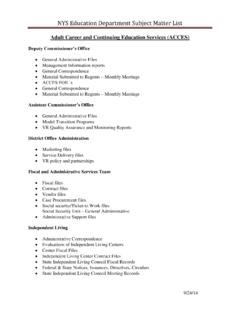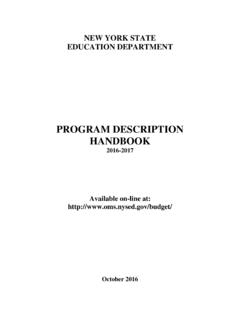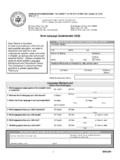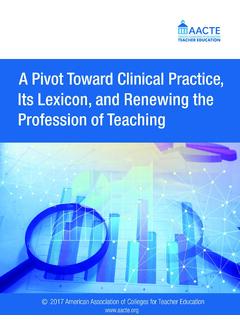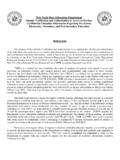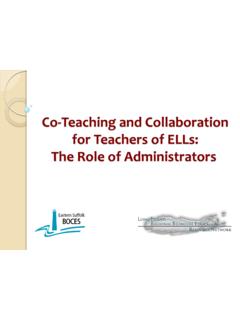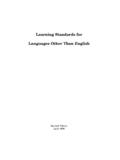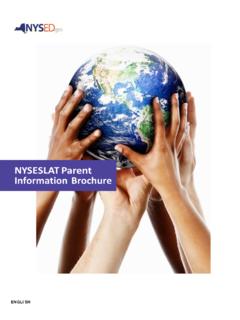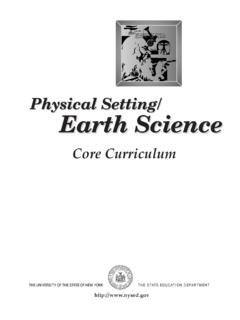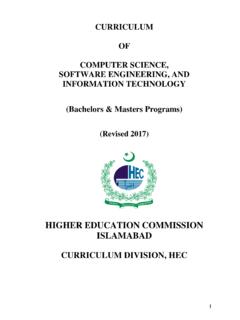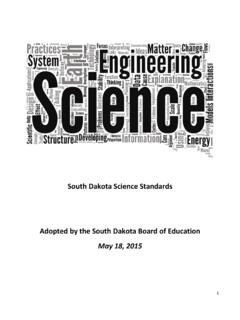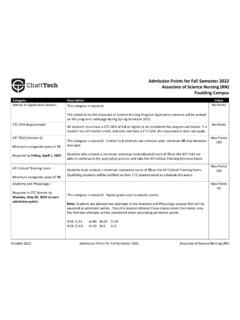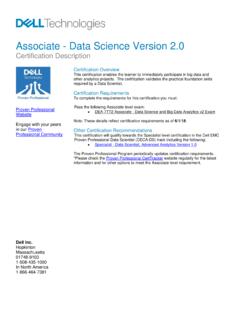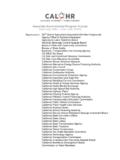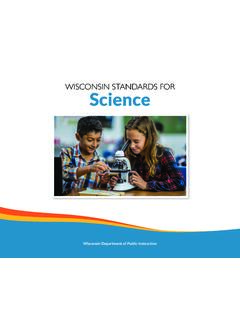Transcription of Intermediate Level Science Core Curriculum Grades 5-8
1 IntermediateIntermediate Level ScienceLevel Science core Curriculum Grades 5-8 THE UNIVERSITY OF THE STATE OF NEW YORK THE STATE EDUCATION DEPARTMENT THE UNIVERSITY OF THE STATE OF NEW YORK Regents of The University CARL T. HAYDEN, Chancellor, , ..Elmira DIANE O NEILL MCGIVERN, Vice Chancellor, , , ..Bayside J. EDWARD MEYER, , ..Chappaqua R. CARLOS CARBALLADA, Chancellor Emeritus, ..Rochester ADELAIDE L. SANFORD, , , ..Hollis SAUL B. COHEN, , , ..New Rochelle JAMES C. DAWSON, , , , ..Peru ROBERT M. BENNETT, , ..Tonawanda ROBERT M. JOHNSON, , ..Lloyd Harbor PETER M. PRYOR, , , , ..Albany ANTHONY S. BOTTAR, , ..Syracuse MERRYL H. TISCH, , ..New York HAROLD O. LEVY, , (Oxon.), ..New York ENA L. FARLEY, , , ..Brockport GERALDINE D.
2 CHAPEY, , , ..Belle Harbor RICARDO E. OQUENDO, , ..Bronx President of The University and Commissioner of Education RICHARD P. MILLS Chief Operating Officer RICHARD H. CATE Deputy Commissioner for Elementary, Middle, Secondary, and Continuing Education JAMES A. KADAMUS Coordinator of Curriculum and Instruction ROSEANNE DEFABIO The State Education Department does not discriminate on the basis of age, color, religion, creed, dis ability, marital status, veteran status, national origin, race, gender, genetic predisposition or carrier sta tus, or sexual orientation in its educational programs, services, and activities. Portions of this publica tion can be made available in a variety of formats, including braille, large print or audio tape, upon request. Inquiries concerning this policy of nondiscrimination should be directed to the Department s Office for Diversity, Ethics, and Access, Room 152, Education Building, Albany, NY 12234.
3 CONTENTS Acknowledgments ..iv core Curriculum ..1 Preface ..3 Standards 1, 2, 6, and 7: Expanded Process Skills ..4 Process Skills Based on Standard 4 ..10 Standard 4: The Living Environment ..12 Standard 4: The Physical Setting ..21 Appendix A: Intermediate Level Science Examination Description ..29 Appendix B: Examples of Activities to Build Skills to Support Standards 1 and 4 ..30 Intermediate Science iii ACKNOWLEDGMENTS The State Education Department acknowledges the assistance of teachers and school administrators from across New York State. In particular, the State Education Department would like to thank: Gioia B. Aldrich Syosset Central School District, Syosset John Bartsch Amsterdam High School, Amsterdam Bonnie Bourdage Johanna Perrin Middle School, Fairport Karen Brownell Wilbur H.
4 Lynch Middle School, Amsterdam John-Michael Caldaro Shenendehowa Junior High Schools, Clifton Park Patrick Chierichella Seneca Junior High School, Sachem Edward Denecke Multidisciplinary Resources Center, NYC Stacy Douglas Community School District 6, NYC Clifford Fee Multidisciplinary Resources Center, NYC Raune Anne Hamilton AuSable Valley Central School, AuSable Valley Molly Heatherington Ross Middle School, Henrietta Nicholas J. Hejaily Williamsville Central Schools, Williamsville Wilford Hemans Middle School 143, Bronx Elaine Jetty Ravena-Coeymans-Selkirk Central School District Michelle Kopp Van Antwerp Middle School, Niskayuna Valentina Krauss Van Antwerp Middle School, Niskayuna Sandra Latourelle SUNY Plattsburgh and Clinton Community College Mary Marcinkowski Niagara Falls Central School District, Niagara Fall Lynn Ocorr Canandaigua Academy, Canandaigua James Overhiser Groton Central School, Groton Odille Santiago Community School District 6, NYC Arnold Serotsky Greece-Athena Middle School, Rochester Ida Swenson East Middle School, Binghamton Ann Tebbutt Sagamore Junior High School, Sachem Joan Wagner Burnt Hills-Ballston Lake Central School, Burnt Hills Additionally.
5 Thanks to our Intermediate Level editors: Dennis DeSain (retired) Averill Park High School, Averill Park John Kuzma Sand Creek Middle School, South Colonie Michael Mosall Greenville Jr/Sr High School, Greenville Fran Pilato Rensselaer Jr/Sr High School, Rensselaer The project manager for the development of the Intermediate Level Science core Curriculum was Diana K. Harding, associate in Science Education, with content and assessment support provided by Judy Pinsonnault, associate in Educational Testing; Elise Russo, associate in Science Education; and the Intermediate Science Assessment Liasons and their project managers Rod Doran and Doug Reynolds. Special thanks go to Jan Christman for technical exper-tise. Intermediate Science iv IntermediateIntermediate Level ScienceLevel Science core Curriculum Grades 5-8 Intermediate Sciencee 2 PREFACE This Intermediate Level Science core Curriculum has been written to assist teachers and supervisors as they pre-pare Curriculum , instruction, and assessment for the Intermediate Level ( Grades 5, 6, 7, and 8) content of Standards 1, 2, 4, 6, and 7 of the New York State Learning Standards for Mathematics, Science , and Technology.
6 The Learning Standards for Mathematics, Science , and Technology identify Key Ideas and Performance Indicators. Key Ideas are broad, unifying, general statements of what students need to know. The Performance Indicators for each Key Idea are state-ments of what students should be able to do to provide evidence that they understand the Key Idea. As part of this continuum, this core Curriculum guide presents Major Understandings that give more specific detail to the concepts underlying each Performance Indicator. This core Curriculum is not a syllabus. It addresses only the content and skills to be tested by the Intermediate Level Science Assessment. The core Curriculum has been prepared with the assumption that the content and skills as outlined in the Learning Standards for Mathematics, Science , and Technology at the elementary Level have been taught previously.
7 This is a guide for the preparation of Intermediate Level curricu-lum, instruction, and assessment, the middle stage in a K-12 continuum of Science education. The lack of detail in the document should not be seen as a shortcoming. Rather, the focus on conceptual understanding in the guide is consistent with the approaches recommended in the National Science Education Standards and Benchmarks of Science Literacy: Project 2061. It is essential that instruction focus on understanding important relationships, processes, mechanisms, and applications of concepts. Less important is the memo-rization of specialized terminology and technical details. Future assessments will test students ability to explain, analyze, and interpret scientific processes and phenomena more than their ability to recall specific facts.
8 It is hoped that the general nature of these state-ments will encourage the teaching of Science for under-standing, instead of for memorization. The question has been asked for each Key Idea: What do students need to know to have Science literacy within that broad theme? The general nature of the Major Understand-ings in this guide will also permit teachers more flexi-bility in instruction and greater variation in assessment than would a more explicit syllabus. The order of presentation and numbering of all state-ments in this guide are not meant to indicate any rec-ommended sequence of instruction. For example, in the Living Environment section, teachers may decide to deal with the concepts in Key Idea 4 before Key Ideas 2 and 3. Major Understandings have not been prioritized, nor have they been organized in any manner to indi-cate time allotments.
9 Teachers are encouraged to find and elaborate for students the conceptual cross-link-ages that interconnect many of the Key Ideas to each other and to other mathematics, Science , and technol-ogy learning standards. The courses designed using this core Curriculum will hopefully prepare our students to explain, both accu-rately and with appropriate depth, the most important ideas about our physical setting and our living environ-ment. Students, in attaining Science literacy, ought to be able to give these explanations, in their own words, by the time they graduate and long after they have com-pleted their high school education. The Science educa-tors throughout New York State who collaborated on the writing of this guide fervently hope that this goal is realized in the years ahead. Laboratory Recommendations: Critical to understand-ing Science concepts is the use of scientific inquiry to develop explanations of natural phenomena.
10 Therefore, it is recommended that students have the opportunity to develop their skills of analysis, inquiry, and design through active laboratory work on a regular basis in Grades 5, 6, 7, and 8. Prior to the written portion of the Intermediate Level Science Assessment, students will be required to com-plete a laboratory performance test during which con-cepts and skills from Standards 1, 2, 4, 6, and 7 will be assessed. Intermediate Science 3 STANDARDS 1, 2, 6, AND 7: EXPANDED PROCESS SKILLS Science process skills should be based on a series of discoveries. Students learn most effectively when they have a central role in the discovery process. To that end, Standards 1, 2, 6, and 7 incorporate in the Intermediate core Curriculum a student-centered, problem-solving approach to Intermediate Science . The following is an expanded version of the skills found in Standards 1, 2, 6, and 7 of the Learning Standards for Mathematics, Science , and Technology.
